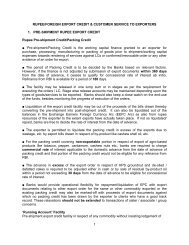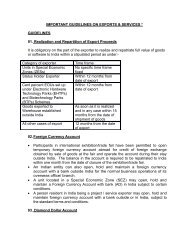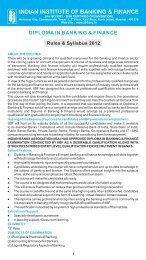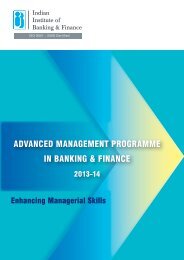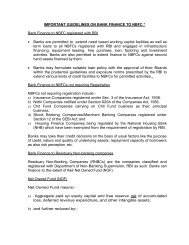Create successful ePaper yourself
Turn your PDF publications into a flip-book with our unique Google optimized e-Paper software.
Unsuitable products or servicesThe products that the banks offer should meetthe customers' demands and expectations. Of latethere are complaints that the product or servicesoffered to the customers are not satisfying theirexpectation. This is a fact in many of the advisoryproducts such as derivatives, mutual funds andinsurance. RBI has slapped fine on various banksfor selling derivatives without carrying the duediligence with regard to the suitability of productsto the particular customer, the latest one being the`1.95 crore penalty on 19 banks**. Most of theadvisory products such as mutual funds, insuranceare sold without properly illustrating the inherentrisk on the particular products. It is also learnedthat the risk appetite of the customer is also notconsidered by the banks while promoting theseproducts which lead into a feeble situation for thecustomer and the banks.Inadequate knowledge“Caveat Emptor” (Let the buyer beware) may be aknown doctrine in trade. But when it comes to bankingproducts and services the onus lies on the banksto make the customer aware of the risk in therespective products. Morally the doctrine applieshere is “Caveat Venditor” (Let the seller beware).The word morally is used here as there is no legalbinding on the banks when the customer signs theapplication along with terms and conditions. But ifthe details are made known to the customer beforetaking the decision, it would avoid many embarrassingsituations later. We are witnessing large number ofcomplaints on credit cards and loans. Credit cardcomplaints tops the above BO complaint table forthe year 2008-09 and 2009-10 with 25.5% and 23.7%respectively. This arises out of the ignorance of thecustomer on part of the billing or payment cycle.Failure to meet commitmentsWhen a commitment is made by the bank, it shouldbe honored with out fail. If the commitments comeswith any pre-condition that should be informed tothe customer well in advance. There are cases wherespecial featurethe commitment is partially / not fulfilled. This leadsto the dissatisfaction which ultimately leads to losingthe customer or facing the legal action and sometimesboth. The presence of numerous print and onlinemedias makes the situation worse as they publishsuch negative news with greater importance. Thistarnishes the reputation of the banks. There are 14.6%BO complaints received in the year 2009-10 under thecategory failure to meet commitments.All the above clearly narrates the lack of transparencyand lack of awareness. A well informed ordinarycustomer is far better than an ignorant but loyalcustomer.What is an ideal customer service?The above question arises in our mind when wetalk about customer service. We can say that itis the most difficult question to answer. Because idealcustomer requires to deal with the expectationsand perception of the customer. Most of the Indiancustomers are not outspoken. They hardly expressthemselves even when they are asked for a feedback.In majority of cases dissatisfied customer neverconveys the same to the respective authorities. Theysimply walk away from the existing bank and lookfor another one. Often they narrate the same totheir friends and relatives and advise them not tobank with the particular bank.On the other hand an effective and consistentcustomer service serves as a marketing as wellas growth tool. A happy customer introduces newcustomers. Good, consistent service also helps toretain the existing customers. Because of recurringnature of the banking services, customers alwaysexpect same level of service in their each interaction.Moreover a good service helps to enhance therelationship value of the existing clients. This is inmarketing terms known as “Customer Loyalty” whichmakes the customer to use the services more oftenand brings even more customers. The| cost ofacquiring a new relationship is higher. Longer therelationships lower the cost. A customer who stayswith us for a long time thus increases the profitability.The Journal of Indian Institute of Banking & Finance October - December 2011 39



